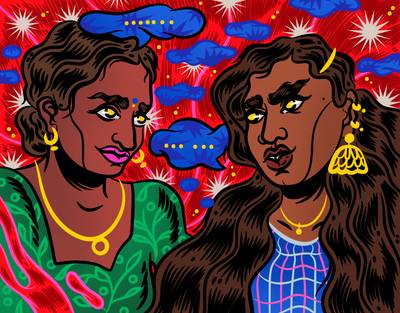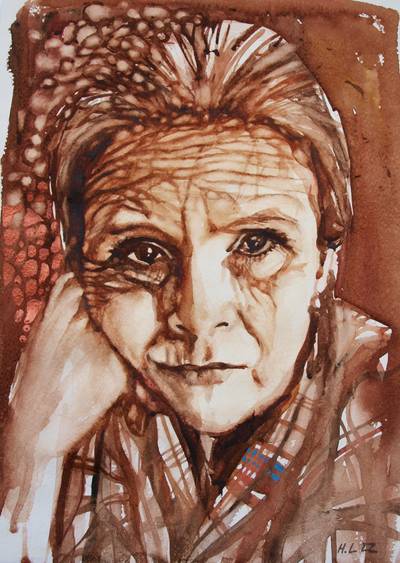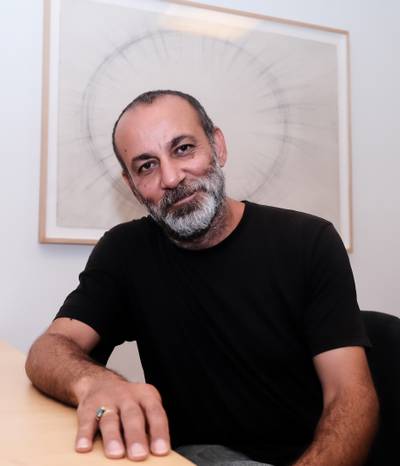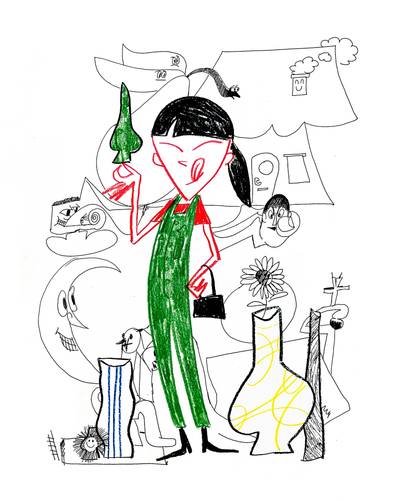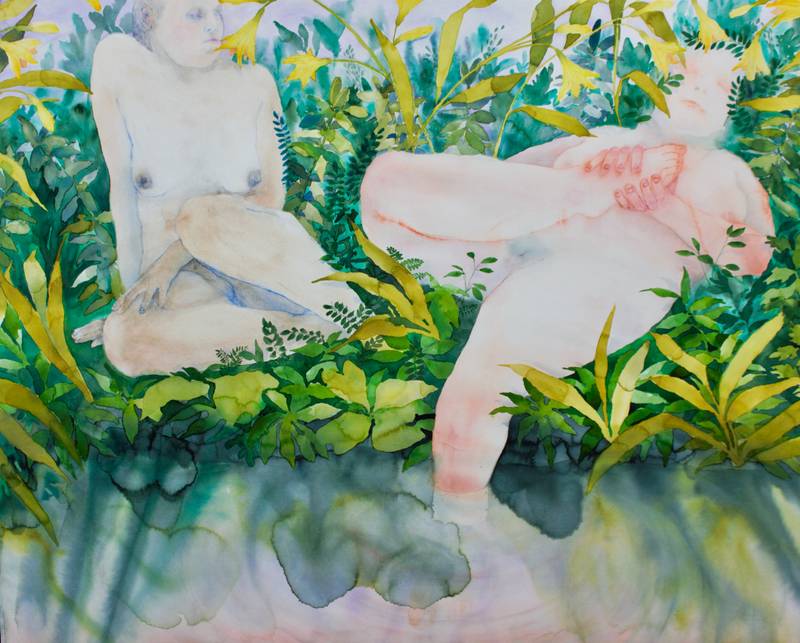

Sirkku Rosi, There Must Be Something In the Water
Sakari Tervo is a university teacher at Aalto ARTS and prior to that he was a lecturer of exhibition studies at the Academy of Fine Arts, Uniarts. Tervo has done independent curatorial work with a series of online publications and has been an active member of the artist-run spaces Sorbus in Helsinki and Titanik in Turku. “For me, art is a social weave where other possible worlds exist.”
I consider writing about paintings rather challenging. It’s the fact that once you morph paintings into fixed words, things start to sound silly (or at least in my case). Hence, I felt the need to express my limitations to Sirkku before carrying out this interview, and I was happy that she accepted my proposal to talk about things around and over her paintings. We also know each other from way back but haven’t met in years. This interview offered the perfect excuse to catch up with Sirkku one sunny spring day at Kaisaniemi Botanic Garden.
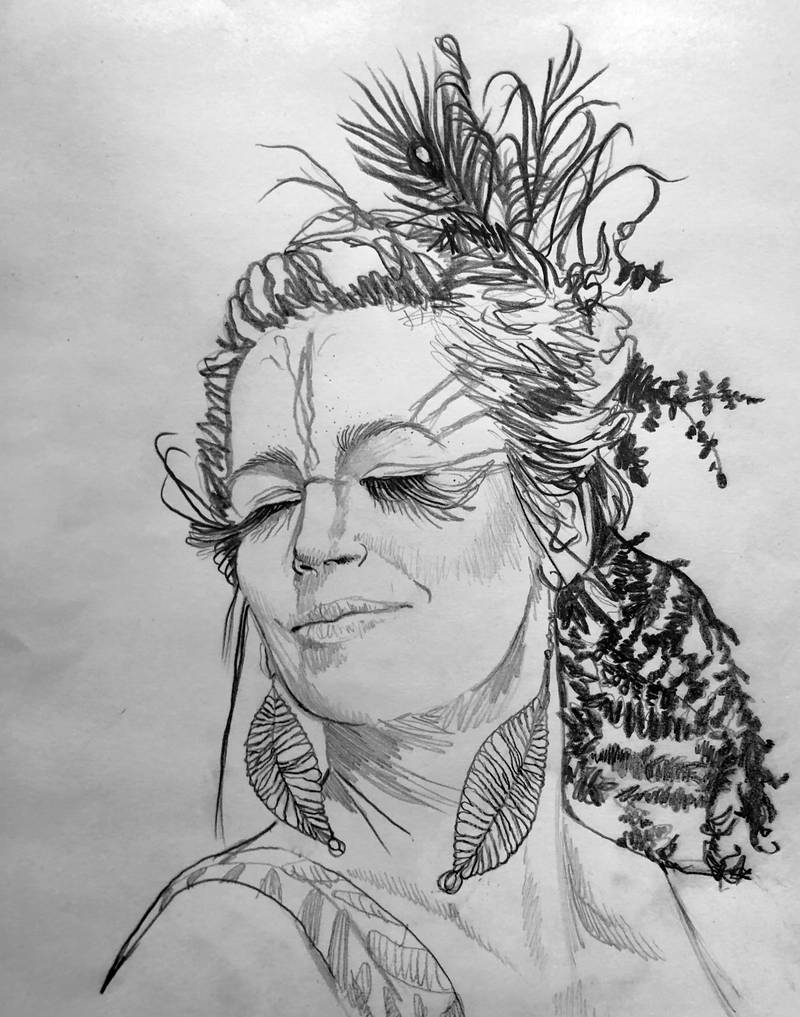

Portrait of Sirkku Rosi by Anna Tahkola
SAKARI: So nice to see you! I think that we first met over fifteen years ago when you were studying art pedagogy at TAIK (these days Aalto University) at the same time as my twin Juuso. We were semi-regularly going to the same parties etc., but I realised that it had been almost how-many-years since we last met! Hence, I’d start this interview with a broad and challenging question: How are you doing, and what have you been up to?
SIRKKU: Yeah, that’s a broad question, hah! For the last six years, I have been living with my partner in Lempäälä, a town next to Tampere. We have chickens, and we live next to a lovely small lake, so I go ice swimming quite regularly during wintertime. I was teaching full time for a while in Senior High School at Tampere, but I have been focusing more on my artistic practice for the last three years. Now I am also studying at the Academy of Fine Arts Helsinki.
Do you think that your background in teaching has a role in your artistic practice?
I am not sure if it has a role in my artworks, but I see it as an essential thing for me to do. I sometimes get frustrated with how lonely it is to paint at home or in a studio, so I really enjoy it when I can go to teach every now and then. Stepping into that world for a while and being part of a community feels good and important. I am not always sure if my art is necessary for society, but teaching is.
I thought that for this interview, we could focus on talking about your latest exhibition, A fourth round of applause, which took place last March at Gallery Huuto, Helsinki. The exhibition featured watercolors of naked bodies merging with various plants and, using part of your press release, “created a landscape where a utopia and dystopia were woven together to form an integrated garden.” Since I did not visit the exhibition “in flesh”, I decided that we would meet up here at Kaisaniemi Botanic Garden to achieve at least some sort of setting that one could have imagined entering while visiting your exhibition. Would you like to say something first about this exhibition?
There were many themes that I have been working on for quite a long time. Like the idea of shared flesh or nonverbal knowledge with all kinds of beings. That all kinds of beings have cells which resonate with each other. Also, as a painting medium and subject matter, water has been my interest for a long time. Astrid Neimans’s “Bodies of Water” strongly influenced me. There is something incredibly beautiful and huge but at the same time something fragile in this idea of this circulation that happens on all the levels simultaneously.
I do not usually use models when I paint bodies since my paintings are not portraits, and they do not need to be anatomically correct. I typically take the positions myself, and I try to sense how my body feels or the feeling of the position in my flesh. I have been working with dance and performance, so I think this comes from there.
The exhibition was built around one big painting, which I could not see as a whole before I installed it in the exhibition space. I was painting it piece by piece, and I was unsure how it would turn out, but luckily it turned out nicely.

I do not usually use models when I paint bodies since my paintings are not portraits, and they do not need to be anatomically correct. I typically take the positions myself, and I try to sense how my body feels or the feeling of the position in my flesh.
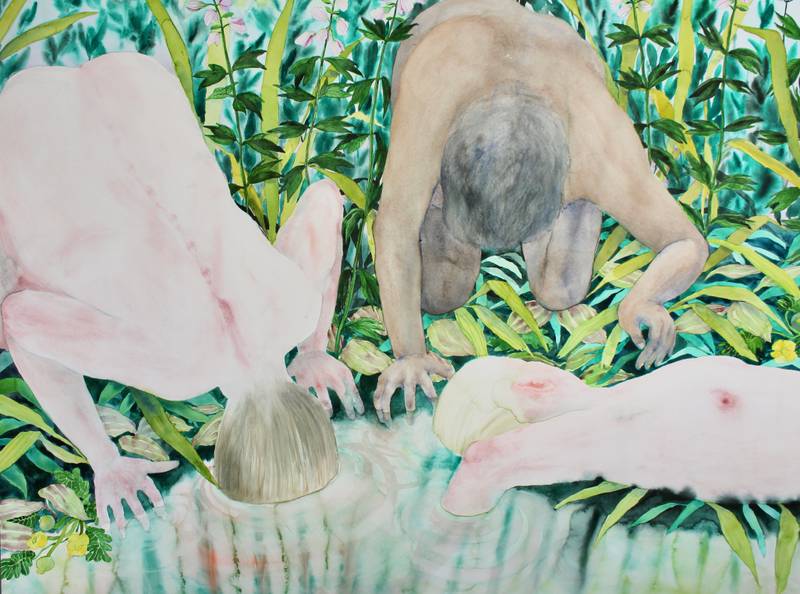

Sirkku Rosi, Kaikki kaipaavat nimiä
When I look at your paintings (from my laptop underneath this palm tree), things that come to mind are sex, death, fear, desire, anxiety, passion, and things like body as a platform for Others or body as a site where worlds merge, rather than as something separate /or standalone. They also bring to mind Emanuele Coccia’s book “The Life of Plants: A Metaphysics of Mixture”, where Coccia argues that plants occupy the fundamental position from which we should analyze all elements of life, and we should not perceive the world as a simple collection of objects, but as the site of a veritable metaphysical mixture. Are you familiar with this book? Is this something that you see resonating with your work?
I read half of the book when I was visiting a friend who had it, and it’s interesting. Also, the things that you said about my works were quite correct, and I liked how you were telling them as a list because I like to think that my works have many layers to them. Some people see my works as very sexual, but they are not as sexual as people think. Or my main goal is not usually to make sexual pictures, but I see sexuality as a naturally integrated part of being. My works are about decaying and growth and how it all happens simultaneously, in circulation.
I think we should learn from other forms of being, but I don’t dare to talk too much about the book since I´ve been mainly glancing at it.
I have not read the book entirely either, and I am not an expert in this field of thought. But when thinking about this kind of metaphysical mixture, or idea where all things are just “one”, I think there can be a risk of forgetting things like power relations, class, race, genders, poverty, etc., that have an actual effect on people’s lives. How do you see this?
We should see these aspects maybe a bit more separately. To not destroy this planet, we should admit the “oneness” of being humble with it, but since we live in a structure built by humans, we also need to criticize, control and solve it. This metaphysical level should not be an excuse.

Some people see my works as very sexual, but they are not as sexual as people think. Or my main goal is not usually to make sexual pictures, but I see sexuality as a naturally integrated part of being. My works are about decaying and growth and how it all happens simultaneously, in circulation.
Your press release phrase about “utopia and dystopia woven together” brings me back to a sentence that I just read somewhere: “paradise has already been lost, so we have to start loving our less-than-paradisiacal world”. I like this combination of hope and hopelessness, which also occupies your phrase. I think its charm is the idea that the possibility for change is already here or out there rather than in unachievable dimensions. Just thinking quite broadly, how do you see this in relation to your artistic practise? Do you think that by making art, one can impact social issues? Or what can art do?
All small things matter because they evaluate our thinking, and trivial things can be seen as passages to bigger ones. Art can easily be seen as an ineffective way of changing the world, but I think there is this common memory, or heritage, in art, which acts like roots. Art comes from lived life, from the things we have seen, felt, heard, or explored. It does not come from some inner universe or void, but it is built from the things around us, filtered versions. In this sense, art carries a lot of felt and emotional information, and I think that art in all forms reminds people of these feelings and emotions and, therefore, can impact our actions. So, we must understand the dystopian and utopian within this world in this sense.
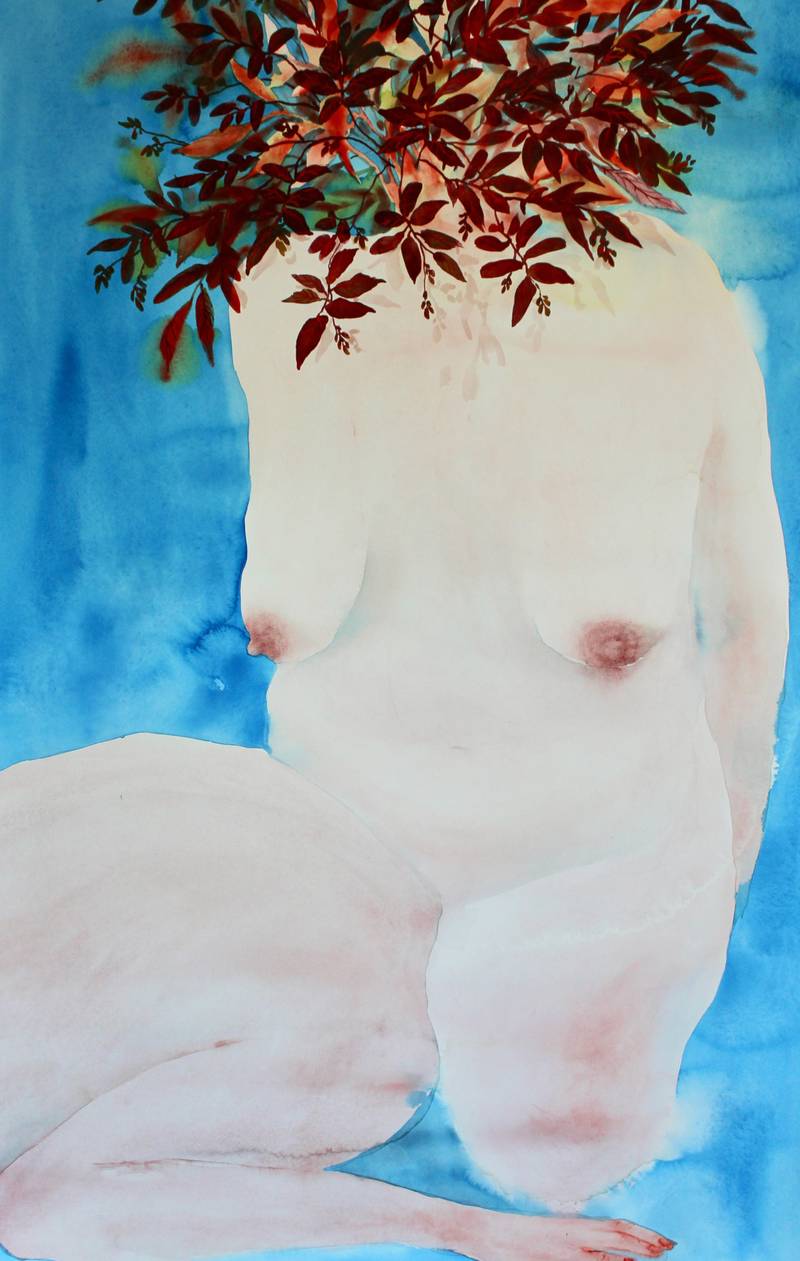

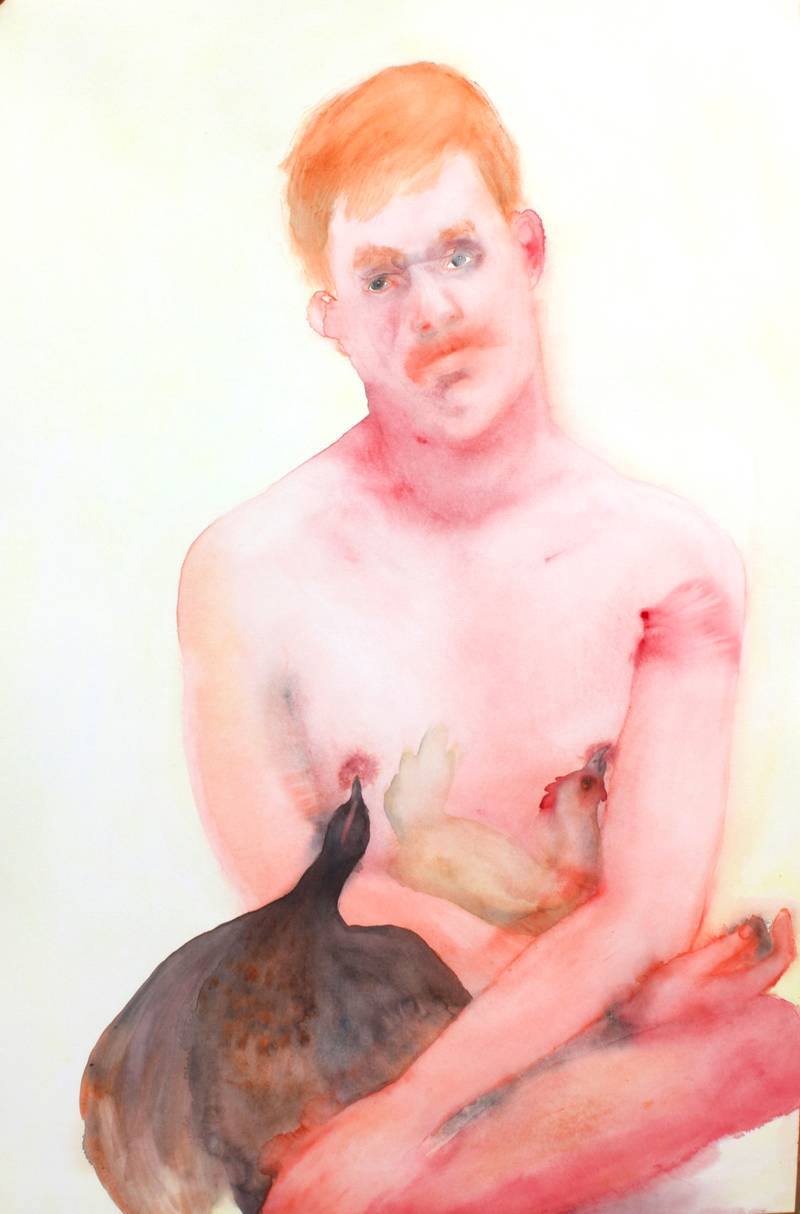

Sirkku Rosi, Haluaisin pohtia tätä vielä hetken
Sirkku Rosi, Imettäjä
I want to ask something practical concerning the act of painting. Watercolors can be perceived as a light and playful technique, but painting with watercolors is a skilful and challenging practice. It’s a demanding balance of handling various stages of wet paper and brushes, water with its own will (so to speak), and something you put on the paper that cannot be removed. Depending on one’s mindset, it’s an irreversible technique, making it an appealing or terrifying technique. Can you talk a bit about your relationship with painting? Or, more specifically, your relationship to watercolors?
Before I started to work with watercolors, I was engaged in the idea that one should be working with several mediums. But when I was on a summer course a few years back where we went out to paint flowers and trees, I realized that all my painting mannerisms, which my teachers had been complaining about, were working perfectly with aquarelles! So, it was an instant love relationship, and I have been focusing almost solely on watercolors since. And because I’m a bit allergic, I don’t even have to use any poisonous stuff, which is lovely.
But as you said, you cannot control everything with watercolors, and I enjoy it. I like when water makes some decisions for me, and I want to see mistakes as gifts. Or that there are things that I cannot work on forever or that I cannot decide everything. I think it’s more fun than terrifying to paint and leave the wet papers on the studio floor. It’s fascinating to see what they have become because they usually offer surprises.
I think this can be a tricky question, but I will ask it anyhow: Do you have a set of favorite painters or a painter that you relate to?
I am sure that I have, but I always forget the names when they are asked. I would like to say some contemporary ones, which I think would be interesting to mention, but somehow the names just run away! I tend to look at different things from different artists. From someone’s work, I might look at how the works are installed, from someone else how the details are done, and from another, how the color is used. So it’s like watching things to learn. I can mention older ones like Hieronymus Bosh, but with the contemporary artists, it is always this embarrassing blackout.
No worries! I tend to blackout as well when asked this question. It’s not as simple a question as it might seem since, at least myself, I would like to remember all of them, and that’s impossible, hah!
I would like to end our talk by giving you the possibility to say something that you would like, need, or want to speak to the readers of this interview. In a way, I want to give you a space within this text which I do not predefine. So please feel free:
Well, there was none of my bush pissing paintings in this exhibition, which are my long-term interest and are related to the idea of circulation and life in general. I see bush pissing as an intriguing physiological and sociopolitical act since it’s viewed differently if the male or female body is pissing in the bushes. At least in Finland, it’s normal if guys are pissing in the parks, but it’s different for women. And I think it’s pretty annoying that human waste and urine are globally polluting the seas, as we are producing synthetic urea for agriculture at the same time. Bush pissing is a beautiful moment where the body is connected to nature. If you piss outside, your fluids are simultaneously in your body and on the ground.
So, summer is coming; let’s all go out and enjoy pissing in the bushes!
